
A picornavirus is a virus belonging to the family Picornaviridae, a family of viruses in the order Picornavirales. Vertebrates, including humans, serve as natural hosts. Picornaviruses are nonenveloped viruses that represent a large family of small, cytoplasmic, plus-strand RNA (~7.5kb) viruses with a 30-nm icosahedral capsid. Its genome does not have a lipid membrane. Picornaviruses are found in mammals and birds. There are currently 80 species in this family, divided among 35 genera. Notable examples are Enterovirus, Aphthovirus, Cardiovirus, and Hepatovirus genera. The viruses in this family can cause a range of diseases including paralysis, meningitis, hepatitis and poliomyelitis. Picornaviruses are in Baltimore IV class. Their genome single-stranded (+) sense RNA is what functions as mRNA after entry into the cell and all viral mRNA synthesized is of genome polarity. The mRNA encodes RNA dependent RNA polymerase. This polymerase makes complementary minus strands of RNA, then uses them as templates to make more plus strands. So, an overview of the steps in picornavirus replication are in order: attachment, entry, translation, transcription/genome replication, assembly and exit.
VPg is a protein that is covalently attached to the 5′ end of positive strand viral RNA and acts as a primer during RNA synthesis in a variety of virus families including Picornaviridae, Potyviridae and Caliciviridae. The primer activity of VPg occurs when the protein becomes uridylated, providing a free hydroxyl that can be extended by the virally encoded RNA-dependent RNA polymerase. For some virus families, VPg also has a role in translation initiation by acting like a 5' mRNA cap.
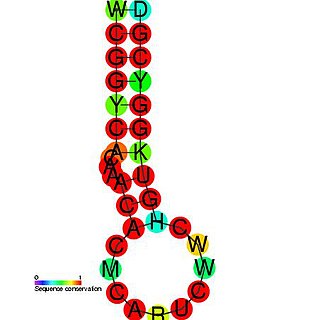
This family represents a Cardiovirus cis-acting replication element (CRE) which is located within the region encoding the capsid protein VP2 and is required for viral replication.

The Citrus tristeza virus replication signal is a regulatory element involved in a viral replication signal which is highly conserved in citrus tristeza viruses. Replication signals are required for viral replication and are usually found near the 5' and 3' termini of protein coding genes. This element is predicted to form ten stem loop structures some of which are essential for functions that provide for efficient viral replication.

The Coronavirus 3' UTR pseudoknot is an RNA structure found in the coronavirus genome. Coronaviruses contain 30 kb single-stranded positive-sense RNA genomes. The 3' UTR region of these coronavirus genomes contains a conserved ~55 nucleotide pseudoknot structure which is necessary for viral genome replication. The mechanism of cis-regulation is unclear, but this element is postulated to function in the plus-strand.

The Coronavirus packaging signal is a conserved cis-regulatory element found in Coronavirus which has an important role in regulating the packaging of the viral genome into the capsid.

The coronavirus SL-III cis-acting replication element (CRE) is an RNA element that regulates defective interfering (DI) RNA replication.

The Enterovirus 5' cloverleaf cis-acting replication element is an RNA element found in the 5' UTR of Enterovirus genomes. The element has a cloverleaf like secondary structure and is known to be a multifunctional cis-acting replication element (CRE), required for the initiation of negative strand RNA synthesis.
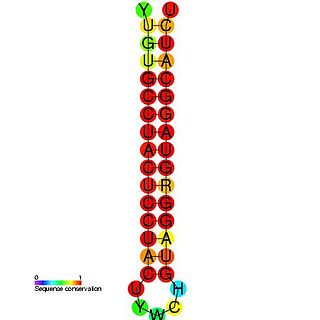
The Hepatitis C stem-loop IV is part of a putative RNA element found in the NS5B coding region. This element along with stem-loop VII, is important for colony formation, though its exact function and mechanism are unknown.

The Hepatitis C virus (HCV) cis-acting replication element (CRE) is an RNA element which is found in the coding region of the RNA-dependent RNA polymerase NS5B. Mutations in this family have been found to cause a blockage in RNA replication and it is thought that both the primary sequence and the structure of this element are crucial for HCV RNA replication.
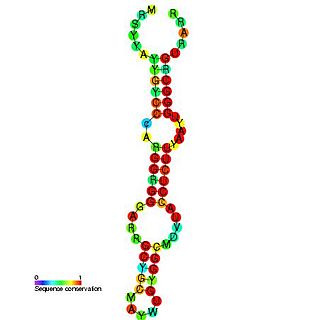
Hepatitis C virus stem-loop VII is a regulatory element found in the coding region of the RNA-dependent RNA polymerase gene, NS5B. Similarly to stem-loop IV, the stem-loop structure is important for colony formation, though its exact function and mechanism are unknown.
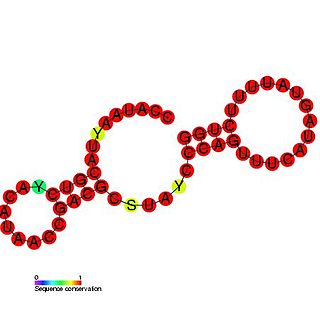
The Potato virus X cis-acting regulatory element is a cis-acting regulatory element found in the 3' UTR of the Potato virus X genome. This element has been found to be required for minus strand RNA accumulation and is essential for efficient viral replication.
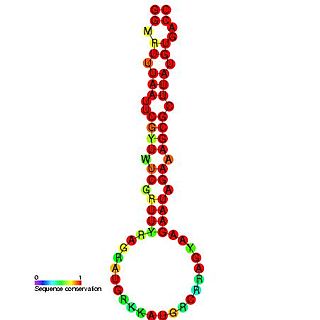
This family represents a rotavirus cis-acting replication element (CRE) found at the 3'-end of rotavirus mRNAs. The family is thought to promote the synthesis of minus strand RNA to form viral dsRNA.

Human rhinovirus internal cis-acting regulatory element (CRE) is a CRE from the human rhinoviruses. The CRE is located within the genome segment encoding the capsid proteins so is found in a protein coding region. The element is essential for efficient viral replication and it has been suggested that the CRE is required for initiation of minus-strand RNA synthesis.
Cis-acting replication elements bring together the 5' and 3' ends during replication of positive-sense single-stranded RNA viruses and double-stranded RNA viruses.
In molecular biology, the Hepatitis A virus cis-acting replication element (CRE) is an RNA element which is found in the coding region of the RNA-dependent RNA polymerase in Hepatitis A virus (HAV). It is larger than the CREs found in related Picornavirus species, but is thought to be functionally similar. It is thought to be involved in uridylylation of VPg.
In molecular biology, the Norovirus cis-acting replication element (CRE) is an RNA element which is found in the coding region of the RNA-dependent RNA polymerase in Norovirus. It occurs near to the 5' end of the RNA dependant RNA polymerase gene, this is the same location that the Hepatitis A virus cis-acting replication element is found in.
In molecular biology, the Avian encephalitis virus cis-acting replication element (CRE) is an s an RNA element which is found in the coding region of the RNA-dependent RNA polymerase in Avian encephalitis virus (AEV). It is structurally similar to the Hepatitis A virus cis-acting replication element.















